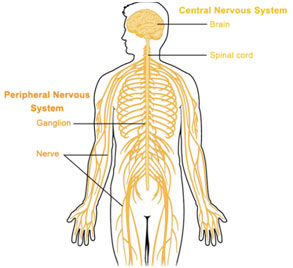The nervous system is a highly intricate part of an animal that coordinates its actions and sensory information by transmitting signals to and from different parts of the body.
The nervous system perceives environmental changes that affect the body, then works in coordination with the endocrine system to respond to such actions.
Nervous Coordination
This type of co-ordination includes specialized cells or neurons linked together directly or via the central nervous system, to form a network that links the cell or organs which receive stimuli (receptors) and those which carry out actions or responses (effectors).
The neuron has the capability to produce and carry out impulses which travel across the synapse and pass from the receptors to the effectors, brings about nervous coordination.
The components of the nervous system which help in co-ordination are:
- 1.Receptors
- 2. Nerve cells
- 3. Effectors
1.Receptors
The nerve cell fibers and cell bodies can be excited by little electrical shocks, mechanical, chemical, light, and temperature stimuli. Receptors detect changes in the external and internal environment of the organism. The receptor may be a cell, or neuron ending, or a receptor organ. Receptors are classified as follows:
- (a) Chemoreceptors: These are for odor, taste, blood, CO2 oxygen, glucose, amino acids, and fatty acids (e.g. receptors in the hypothalamus).
- (b) Mechanoreceptors: These perceive stimuli of touch pressure, hearing, and balance (e.g. Free nerve endings + expanded lip endings + stray endings).
- (c) Photoreceptors: (electro-magnetic receptors), these respond to stimuli of light for instance in eyes, rods, and cones.
- (d) Thermoreceptors: These are totally free nerve endings. These respond to cold and hot temperatures.
- (e) Nociceptors: (Undifferentiated endings) which produce the feeling of pain.
2.Neurons
The chief structural and functional systems of the nervous system are nerve cells or neurons, but there are other cells, in higher animals, and in human beings called neuroglia, which makes up as much as half of the nervous system. Neuroglia play an essential role in the nutrition of neurons and their protection by a myelin sheath.
There are three functional kinds of neurons-the sensory, associative (intermediate/ relay), and motor neurons, in mammals.
Structure of neurons
The main parts of the nerve cell are the soma (cell body), the axon (a long and lean projection that conducts electrical impulses away from the cell body), dendrites (tree-like structures that receive messages from other neurons), and synapses (specialized junctions in between neurons).
Microtubules, neurofibrils, rough endoplasmic reticulum, and mitochondria are present throughout the axoplasm (cytoplasm of the axon) of the nerve cell. The cell body or soma is the main nutritional part of the cell and is concerned about the biosynthesis of materials necessary for the development and upkeep of the neurons. If the cell body of the neuron stays undamaged, it can regenerate axonal and dendrite fibers; but nerve cells once develop, do not divide anymore.

Types of neurons
Sensory neurons
Sensory neurons or afferent neurons send information from sensory receptors in the skin, or the internal organs towards the Central Nervous System for processing.
Motor neurons
Motor or efferent neurons send details away from the Central Nervous System towards some type of effector. Motor neurons have long axons that run from the Central Nervous system to the effector (muscle).
Interneurons (Associate/Mixed/Relay neurons)
Interneurons lie in between the motor and sensory paths and are extremely associated with signal integration. The majority of interneurons are restricted within the CNS.
3.Effectors
These are the structures which respond when they are stimulated by impulse coming via means of motor neuron. The principal effectors are glands, which respond by producing secretions; and muscles which react by contracting.
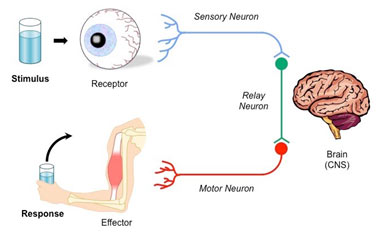
Reflex arc:
The reflex arc is the pathway on the passage of impulse during a reflex action.
Reflex action:
Reflex action is a kind of involuntary action. It is the sudden, smooth, and quick action of the body with the participation of the spinal cord and without the involvement of the brain.
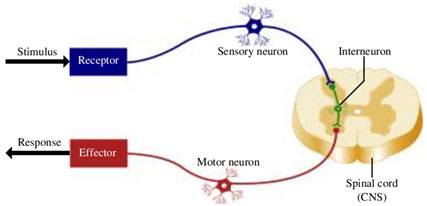
Evolution of Nervous System
There are two types of the nervous system in the animal kingdom.
- A diffused nervous system, such as that of Cnidarians (Hydra, jellyfish, and their relatives).
- A central nervous system, found in varying degrees in more complex organisms, from Platyhelminthes to chordates including humans.
To acknowledge the organization of the above-discussed types of the nervous system, we would study them in Hydra, Planaria, and humans. Nervous system design is extremely co-related to the animal’s lifestyle.
Nervous System of Hydra
The primary type of nervous system is a diffused nervous system. Hydra has this type of nervous system. Hydra, a cnidarian, is a little animal which is sedentary in its lifestyle and prey and other risks are equally likely to come from any direction. Its nerve system consists of a network of nerve cells, which is present between the ectoderm and endoderm.
There is no head in this animal, therefore, there is no centralized nervous system i.e. no brain and neuron network, etc. However, a cluster cell of bodies of neurons forming ganglia can be seen here and there. It has actually been observed that nerve cells are so arranged in the network that it is not possible to differentiate them in connected functional types of neurons as in higher animals i.e. there are no sensory, associative (inter/relay) neurons, or motor nerve cells, there is no specific sense, organs in this animal.
It has been observed and studied that when a suitable stimulus is provided, Hydra reacts – and practically the whole body of the animal responds as a system. The tentacles are more responsive and respond to the stimulus instantaneously.
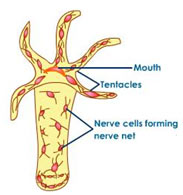
Nervous System of Planaria and Humans
The second kind of nervous system exists in Planaria and humans. It is centralized nervous system. The nervous system of Planaria is much better developed as compared to that of Hydra.
The centralized nervous system begins in planaria. In the anterior region of the body of planaria, there is a bilobed mass composed of two ganglia. This acts as a “brain “or a central collection of neurons. This receives and sends out impulses from and to different parts of the body. There is no such collection of nerve cells or a coordinating centre in Hydra – only a network of neurons is present.
There is a differentiation of nerve cells into sensory associative and motor nerve cells. In Planaria, associative nerve cells exist in the brain and longitudinal nerves. Sensory neurons carry the impulse to the ‘brain’ or nerves and motor nerve cells carry impulse from the main nervous system to different parts of the body. In Hydra, there is no differentiation of nerve cells.
In Planaria at the anterior region, sense organs are present in the form of eyes and chemoreceptors are present. There are no specialized sensory organs in Hydra.
The receptor cells that are sensitive to pressure and touch-are present in Planaria. There are no specialized sensory cells in Hydra, but some neurons are more sensitive to a specific chemical or mechanical stimulus than others.
There are definite longitudinal and lateral nerves in Planaria. There are no nerves in Hydra.
In Planaria in addition to a superficial nerve network simply below the epidermis, there is a much deeper plexus(Brain and longitudinal nerves) embedded in the parenchyma.
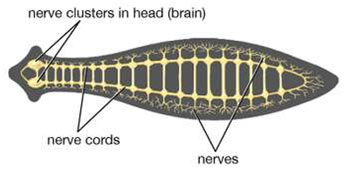
Summary
The nervous system is a highly convoluted and coordinated system in animals. It receives stimuli from surroundings and then produces an appropriate response. This mechanism involves receptors for receiving stimuli. They can be mechanoreceptors, pain receptors, thermoreceptors, or photoreceptors according to their function.
Neurons or nerve cells are the functional and structural unit of the nervous system. They conduct electrical impulses and send information to the brain or from the brain to organs. They can be sensory, motor or interneurons. Neurons have axons which conduct impulse away from the cell and dendrites which conduct impulse towards the cell. Effectors are the structures that produce a response on stimuli.
The animal kingdom has two types of the nervous system
- 1) A diffused nervous system and
- 2) A central nervous system.
Diffused nervous system is present in organisms like cnidaria, jellyfish, etc.
This is the primary type of nervous system. There is no brain or neuron network but the cluster of neuron bodies are present which form ganglia and there are no specific sensory organs in these organisms. It has been observed that on stimuli generally, the whole body of the animal responds. And Central nervous system is found in all organisms from Platyhelminthes to chordates including humans.
These have almost a proper brain and neuron network. They have specific sensory organs for receiving stimuli and effectors for the response which generally are muscles and glands (hormones).
FAQs – Nervous System
1. What is the nervous system? The nervous system is a complex network in animals that coordinates actions and sensory information. It transmits signals to and from different parts of the body, perceiving environmental changes and responding to them.2. How does nervous coordination work? Nervous coordination involves specialized cells or neurons linked together to form a network. Neurons transmit impulses, carrying signals from receptors (which detect stimuli) to effectors (structures that respond to stimuli), creating a coordinated response.
3. What are receptors? Receptors are structures, such as nerve cell fibers or organs, that can be stimulated by electrical shocks, mechanical pressure, chemicals, light, or temperature changes. They detect environmental changes in the organism, and different types include chemoreceptors, mechanoreceptors, photoreceptors, thermoreceptors, and nociceptors.
4. What are neurons, and what is their structure? Neurons are the fundamental units of the nervous system. They consist of a cell body (soma), dendrites (receiving messages), an axon (conducting impulses away from the cell body), and synapses (junctions between neurons). There are sensory neurons, motor neurons, and interneurons, each serving a specific function.
5. What are effectors? Effectors are structures that respond to neural impulses. They include glands, which produce secretions, and muscles, which contract. Effectors carry out the desired response triggered by the impulse from motor neurons.
6. What is a reflex arc? A reflex arc is the pathway of an impulse during a reflex action. Reflex actions are involuntary, quick responses involving the spinal cord without the brain’s direct involvement.
7. How does the nervous system evolve in animals? There are two types of nervous systems: a diffused nervous system found in simpler organisms like Cnidarians (e.g., Hydra), and a central nervous system found in more complex organisms from Platyhelminthes to chordates, including humans. The organization of the nervous system depends on the animal’s lifestyle and complexity.
8. What is the difference between the nervous systems of Hydra, Planaria, and humans? Hydra has a diffused nervous system with no specific sensory organs, while Planaria and humans have a centralized nervous system. Planaria has a more developed system with a brain, sensory organs, and differentiated neurons, whereas humans have a highly evolved central nervous system, including the brain, spinal cord, and specific sensory and motor neurons.
9. What is a reflex action, and how does it work? A reflex action is a quick, involuntary response to a stimulus, involving the spinal cord without direct brain involvement. Reflex arcs, the pathways of impulses during reflex actions, ensure rapid and coordinated responses to stimuli.
10. What are some disorders related to the nervous system? Disorders in the nervous system can lead to various conditions. Mistakes in mitosis may cause numerical alterations in chromosome numbers, contributing to cancer. In meiosis, errors like non-disjunction can result in conditions like Patau syndrome, Edwards syndrome, Down’s syndrome, Klinefelter’s syndrome, Turner’s syndrome, and Jacobs syndrome. These disorders often involve chromosomal abnormalities affecting development and functioning.
Conclusion
In summary, the nervous system is a remarkable and intricate network in animals, vital for coordinating actions and responding to environmental stimuli. The nervous coordination involves specialized cells called neurons, which transmit impulses and form networks connecting receptors to effectors. Receptors detect stimuli, neurons carry impulses, and effectors produce responses.
The nervous system exhibits two primary types across the animal kingdom: a diffused system seen in simpler organisms like Hydra, and a centralized system found in more complex organisms, including humans. While Hydra lacks specific sensory organs, organisms like Planaria and humans have evolved centralized nervous systems with brains, sensory organs, and differentiated neurons.
Understanding the nervous system sheds light on reflex actions, involuntary responses governed by reflex arcs, ensuring rapid and coordinated reactions. Disorders related to the nervous system, such as chromosomal abnormalities during mitosis and meiosis, can lead to conditions like cancer and various syndromes.
The FAQs provided offer insights into the functioning of the nervous system, receptors, neurons, effectors, reflex actions, and the evolution of nervous systems in different organisms. As a complex and adaptive system, the nervous system plays a crucial role in maintaining the equilibrium of living organisms. Always seek professional medical advice for accurate information on specific health conditions related to the nervous system.

